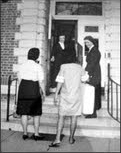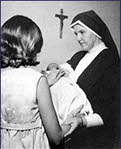By: Leslie Pate Mackinnon, LCSW
HISTORY:
The development of the profession of Social Work is irrevocably linked to the plight of the unmarried mother and not in a way that lends pride to the profession. However, the connection between the two is central to understanding how the field of social work evolved. Social workers in this newly emerging profession came with an agenda to address “illegitimacy” as a way to sharply distinguish themselves from the evangelical women that preceded them. Professional social work’s nineteenth century roots began with charitable works. Social workers claimed their turf as experts in the science of social problems. Many social workers believed that in order to be taken seriously as professionals, they needed to distance themselves from womanly benevolence and understanding.
 They instead extolled the virtues of efficiency, objectivity and expertise, while disparaging the values associated with the earlier movement as overly sentimental and outdated.They defined the field of illegitimacy as a national problem requiring a social work-curative. Social work practitioners transformed “good works” into a profession, and significantly reshaped ideas about illegitimacy and attitudes toward single mothers. Under the perception of social workers, unmarried mothers moved from being victims to becoming “agents” of larger social problems that threatened conventional family life. They were blamed for the rise in divorce, broken homes and desertion.
They instead extolled the virtues of efficiency, objectivity and expertise, while disparaging the values associated with the earlier movement as overly sentimental and outdated.They defined the field of illegitimacy as a national problem requiring a social work-curative. Social work practitioners transformed “good works” into a profession, and significantly reshaped ideas about illegitimacy and attitudes toward single mothers. Under the perception of social workers, unmarried mothers moved from being victims to becoming “agents” of larger social problems that threatened conventional family life. They were blamed for the rise in divorce, broken homes and desertion.
Theories devoted to the causes of illegitimacy went through several distinct phases. During the “benevolent phase,” women were viewed as victims who were seduced and then abandoned. With social work came the language of diagnostic categories. The label of “feeblemindedness” allowed social workers to initially explain out-of-wedlock pregnancy. Pregnant women were sent to homes for the feebleminded, and required to nurse their children for 3 months, in order to facilitate bonding. Since their offspring were also believed to be feebleminded, the goal was that bonded mothers would be discouraged from abandoning their infants in the home and moving on. (During the early 1900s feeblemindedness in men correlated to criminal activity and an inability to succeed economically, feeblemindedness in women was defined almost exclusively in sexual terms.) Sterilization was seen as a “wonderful blessing to the feebleminded girl bound to become a repeater.”
The next phase viewed unmarried mothers as “sexual delinquents.” This repackaged concept occurred as society became more interested in the phenomenon of delinquency. Women in maternity homes were often referred to as inmates and the time spent at the home as incarceration. The 1940s and 50s brought with it a growing recognition of “unconscious dynamics,” and illegitimacy began to be defined in terms of psychological deficits on the part of the mother. The DSM I (Diagnostic Statistical Manual of Mental Disorders) included an “unwed mother” as a diagnostic category. The definition stated: “the neurotic need to have a baby while unmarried.”

In the 1960s, a liberalization of sexual mores combined with restrictions to accessing birth control, led to a dramatic increase in premarital pregnancies. The dominant psychological and social work view was that the large majority of unmarried mothers were unfit to parent because of psychological disturbance and immaturity. Therefore, mother and child were thought to be better off, separated by adoption. In most cases, adoption was presented to the mothers as the only option and little or no effort was made to help the mothers keep and raise the children. As the social work profession evolved, unmarried mothers were treated increasingly punitively and certainly were not offered counseling, other than convincing them to separate from their children.
In what was seen as best for the unmarried mother and the good of her infant, social work theory advanced the notion strongly and swiftly that babies should be placed with mature and capable married parents. These infants were presented by social workers to adopting couples as “unwanted pregnancies,” rather than “unplanned pregnancies.”
TODAY:
So lets look at how social workers offer services to expectant parents today. Thankfully, the field of adoption has changed dramatically in the past 75 years. We’ve moved from clandestine secrecy to varying degrees of openness, in most every adoption. The reality that “adoption is based on loss” has become accepted as a basic premise in our field. Adoption services no longer end at finalization. The past twenty years have welcomed the onset of “post-adoption services.” As a private practitioner who specializes in adoption issues, I’ve had more than one adoption professional jokingly refer to “keeping me in business” by referencing the number of placements that occurred the previous year. Though most assuredly said in jest, such comments have disturbed me greatly. What are we doing as a profession to preserve families? We purport that expectant mothers today have choices. I find that that a misnomer. If we cannot provide specific resources or refer women wanting to parent to social service agencies that offer assistance, what choice are we offering beside adoption? I have yet to meet a woman who didn’t have a desire to parent her child, but I have met many who felt woefully alone and without the financial resources to do so.
Adoption agency social workers send single women who choose to parent kindly on their way. However, if the same woman had chosen placement, she might have a chance to be eligible for assistance with rent, medical expenses and on rare occasion a small stipend for a few weeks following the birth of her child. Often agencies represent not only the expectant parents but also the adopting couple. While each party usually has a separate worker assigned to them, both workers are paid by the adoption agency that runs a business based on the placement of children. This dual representation also occurs with attorneys and independent therapists and raises acute ethical and practical concerns for all these professions. A final factor that interferes with free choice is subtle and/or overt coercion, whether from parents, friends, religious communities or adoption professionals themselves. We know that today, most workers and agencies do not exert overt pressure, but it would be foolish to assume it never occurs.
The concept of “informed consent” applies to a range of decisions in our society. It is considered best practice and is legally mandated prior to receiving medical treatment. Being “fully informed” prior to making a decision about the relinquishment of a child for adoption has not been fully implemented nor legally mandated in our current adoption practice. The repercussions of placing a child for adoption are lifelong. Birthmother grief is the only grief cited by the National Association for Grief and Loss that has been noted to increase over time, rather than dissipate, as is the case in all other forms of grief.
What remains archaic today is how little coursework, if any at all, is taught in graduate schools about the psychological repercussions of adoption for all parties involved. This means that today’s social workers continue to enter the field ill-prepared for work that is extremely complex. I’ve often commented that having treated clients for 38 years, I find the field of adoption more psychologically complex and challenging than all other areas in which I’ve practiced. It takes an inordinate amount of patience as all parties work through their idealized view of adoption and balance that view with some of the harsh realities adoption begets. There are merely a handful of adoption certification programs across the U.S. Not nearly enough to train even a small percentage of professionals in the field. And finally, while it is the exception and not the norm, there continue to be adoption personnel delivering direct services to expectant parents who have absolutely no qualifications in the field of psychotherapy, in what is now recognized as an extremely complex field.
Another remarkable deficit in the field of social work is the lack of research and printed material describing the issues and the recommended treatment for women contemplating placement or those who have already placed. There are no bona fide research studies on birthparents. Additional research is vital in order to develop laws, policies and practices that genuinely address the rights, needs and desires of women and men who choose adoption for their children.
So what kind of report card would you give today’s social worker? We’ve obviously come full circle from a punitive approach back to one of compassion. We’ve learned that birth parents may require psychological services, intermittently, throughout a lifetime. We realize that openness and connection are far better than secrecy and the cessation of relationships. The major goal that requires our ongoing focus is that a social worker’s job is to find a family for a child in need; not one of finding a child for parents. Because adoption has become a billion-dollar industry, it lends itself to compromising the highest standards and “best practice principles” of the profession.


